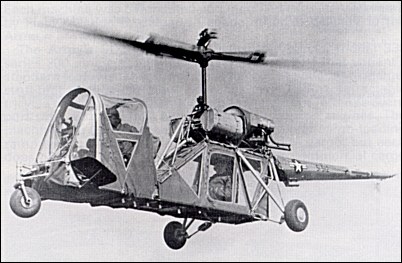|
Seibel first worked with Bell in Arthur Young's team when it was putting the finishing touches to the Model 30. In 1946 he left Bell to take up a position as aerodynamicist with the Boeing Airplane Company for the development of a liaison aircraft.
Seibel, however, did not abandon rotorcraft. In conjunction with George Lubben and Dick Ledwin he built a small helicopter with a rotor of outstanding simplicity. Lateral and longitudinal control were effected by changing the centre of gravity.
Early in 1948 Seibel and his partners formed the Seibel Helicopter Company Inc. and set about building larger aircraft, the S4A and later the S4B.
The Seibel Helicopter Company eventually became a division within the Cessna organization.
1948 S-4A (YH-24 Skyhawk)
The rotor was fitted with the same 'blade attaching angle' system as patented for the S3. In this tandem seating helicopter, the passenger, payload and fuel supply are carried at the centre of gravity, just beneath the main rotor gearbox. YH-24 is the designation of the military version of the S4A.
1949 S-4B
This version of the preceding helicopter differed from it not only in having greater power but also by virtue of a shortened fuselage which could accommodate two pilots side by side. In addition the S-4A's wheeled landing gear was replaced by one fitted with skids. P.Lambermont "Helicopters and Autogyros of the World", 1958
The Seibel Helicopter Company was formed in 1947 by Charles M. Seibel, an engineer formerly employed by Bell Helicopter, and the S-4A Sky Hawk was the second of the firm's designs to fly. Both the Army and the Air Force expressed interest in the Sky Hawk, and in 1951 the Army ordered two examples for operational and engineering evaluation in the observation, utility and aeromedical evacuation roles. The machines were delivered near the end of 1951, designated YH-24, and assigned the serial numbers 51-5112 and -5113,
The YH-24 was of extremely simple welded steel-tube construction, and was unique in having a stepped, two-deck fuselage structure. The long lower deck supported the pilot's seat and control panel, as well as a small passenger/cargo area that was unobstructed and accessible from the rear. The shorter upper deck, directly above the passenger/cargo area, carried the craft's single 125hp Lycoming engine, fuel and oil tanks, and the complete main rotor assembly. A tapered alloy tail boom was attached to the rear of the upper deck, and carried a two-bladed anti-torque rotor at its tip. The pilot's position and passenger/cargo area were not normally enclosed, though they were provided with roll-down fabric and clear plastic panels for use in bad weather. During the course of the Army's evaluation, the fuselage of the second YH-24 (51-5113) was shortened and widened to allow the installation of a co-pilot's seat beside that of the pilot, and the machine was later fitted with skid landing gear in place of its original wheeled tricycle undercarriage.
Though a relatively robust and easily maintained aircraft, the YH-24 was ultimately judged to be unsuitable for Army service, primarily because its load-carrying ability was considered to be too limited to successfully accomplish the aeromedical evacuation and general utility tasks for which it had been evaluated. The two YH-24 prototypes were subsequently dropped from the Army inventory during the latter part of 1952. S.Harding "U.S.Army Aircraft since 1947", 1990
| Technical data for Seibel YH-24
Engine: 1 x Lycoming O-290-D pistone engine, rated at 95kW,
main rotor diameter: 8.88m,
fuselage length: 8.48m,
height: 3.05m,
take-off weight: 695kg,
empty weight: 430kg,
max speed: 105km/h,
cruising speed: 93km/h,
service ceiling: 1310m
|
Warning: mysqli_connect(): php_network_getaddresses: getaddrinfo for mysql5.zone.ee failed: Name or service not known in /data03/virt15346/domeenid/www.aviastar.org/htdocs/helicopters_eng/seibel_s-4.php on line 91
Fatal error: Uncaught mysqli_sql_exception: php_network_getaddresses: getaddrinfo for mysql5.zone.ee failed: Name or service not known in /data03/virt15346/domeenid/www.aviastar.org/htdocs/helicopters_eng/seibel_s-4.php:91
Stack trace:
#0 /data03/virt15346/domeenid/www.aviastar.org/htdocs/helicopters_eng/seibel_s-4.php(91): mysqli_connect('mysql5.zone.ee', 'd14657sa18989', Object(SensitiveParameterValue))
#1 {main}
thrown in /data03/virt15346/domeenid/www.aviastar.org/htdocs/helicopters_eng/seibel_s-4.php on line 91
| 




